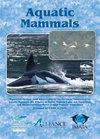Temporary Hearing Threshold Shift in California Sea Lions (Zalophus californianus) Due to a Noise Band Centered at 32 kHz
IF 0.8
4区 生物学
Q4 MARINE & FRESHWATER BIOLOGY
引用次数: 0
Abstract
To determine their frequency-dependent susceptibility to noise-induced temporary hearing threshold shift (TTS), two California sea lions (Zalophus californianus) were exposed for 60 min to a continuous one-sixth-octave noise band (NB) centered at 32 kHz as the fatiguing sound, at sound pressure levels of 132 to 156 dB re 1 µPa (sound exposure levels [SELs] of 168 to 192 dB re 1 µPa2s). Using a psychoacoustic technique, TTSs were quantified at the center frequency of the fatiguing sound and at half an octave and one octave above the center frequency (at 32, 44.8, and 63 kHz). When significant TTS occurred, higher SELs resulted in greater TTSs. TTSs and hearing recovery patterns were similar in both sea lions. The mean onset of TTS1-4 min (defined as 6 dB TTS) in sea lion F01 is estimated to occur after exposure to an SEL of 179 dB re 1 µPa2s (at hearing test frequency 44.8 kHz). After exposure to an SEL of 180 dB re 1 µPa2s, a mean TTS1-4 min of 6.7 dB was measured at hearing test frequency 44.8 kHz. In California sea lions, TTS onset levels are not as closely related (especially at the lower and higher frequencies) to the unmasked hearing thresholds (audiograms) as was previously assumed.加州海狮(Zalophus californianus)因以 32 千赫为中心的噪声频段而出现的暂时性听阈偏移
为了确定它们对噪声引起的暂时性听阈偏移(TTS)的频率依赖性,两只加利福尼亚海狮(Zalophus californianus)被连续暴露在以 32 kHz 为中心的六分之一倍频程噪声带(NB)中 60 分钟,作为疲劳声,声压级为 132 至 156 dB re 1 µPa(声暴露级 [SELs] 为 168 至 192 dB re 1 µPa2s)。利用心理声学技术,在疲劳声的中心频率以及中心频率以上半个八度和一个八度(32、44.8 和 63 kHz)处对 TTS 进行量化。当出现明显的 TTS 时,SEL 越高,TTS 越大。两只海狮的 TTS 和听力恢复模式相似。据估计,海狮 F01 在暴露于 179 dB re 1 µPa2s(听力测试频率为 44.8 kHz)的 SEL 后,平均会出现 1-4 min 的 TTS(定义为 6 dB TTS)。暴露于 180 dB re 1 µPa2s 的 SEL 后,在听力测试频率 44.8 kHz 时测得平均 TTS1-4 min 为 6.7 dB。在加州海狮中,TTS 的起始水平(尤其是低频和高频)与未掩蔽听阈(听力图)之间的关系并不像之前假设的那样密切。
本文章由计算机程序翻译,如有差异,请以英文原文为准。
求助全文
约1分钟内获得全文
求助全文
来源期刊

Aquatic Mammals
MARINE & FRESHWATER BIOLOGY-ZOOLOGY
CiteScore
1.60
自引率
16.70%
发文量
99
审稿时长
>12 weeks
期刊介绍:
Aquatic Mammals is a peer-reviewed journal sponsored by the European Association for Aquatic Mammals (EAAM), the Alliance of Marine Mammal Parks and Aquariums (AMMPA), and the International Marine Animal Trainers’ Association (IMATA). Aquatic Mammals publishes articles related to marine mammals (whales, dolphins, seals, fur seals, sea lions, walrus, dugongs, manatees, sea otters, and polar bears). Topics of publication on both captive animals and wild marine mammals include aspects of husbandry; behavior; conservation; veterinary medicine; anatomy; physiology; training; population trends; and the effects of pollution, climate change, and noise.
文献相关原料
| 公司名称 | 产品信息 | 采购帮参考价格 |
|---|
 求助内容:
求助内容: 应助结果提醒方式:
应助结果提醒方式:


